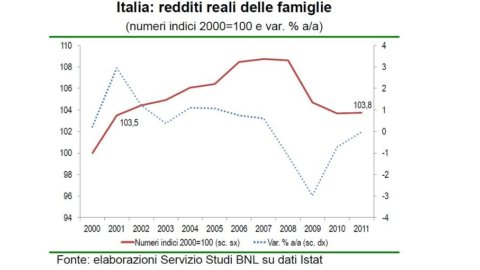INCOME DIFFICULT TO MAINTAIN
The persistence of a rather difficult macroeconomic scenario continues to weigh on the economic and financial condition of Italian families. The increase in gross disposable income on a trend basis in the first three quarters of 2011 (+2,5%) failed to offset the change in prices, thus still determining a period of substantial stability in purchasing power. The last year in which real growth in household income of more than 1% was recorded was 2005. Since then there have been two years of marginal growth (2006-07: +0,8 and +0,6 % respectively) and a three-year period of declines (2008-2010: -1,1%, -2,8%, -0,8%), while a first positive change is expected by some research institutes not before 2014. In absolute values the consistency of the real income of households in the year ending last September (€980 billion) has returned approximately to the levels of the beginning of the millennium.
In fact, between 2008 and 2010 many of the items that contribute to the disposable income of consumer families underwent a sharp reduction. While income from work experienced a decline only in 2009 (-1,1%), the worst year of the recession phase, income from capital (consisting mainly of interest and dividends) recorded three consecutive years of substantial losses (- 0,2%, -35,4%, -5,8%, respectively for a total of -39% over the three-year period), the same as that recorded for the income transferred from producer families to consumer families (-1%, -0,2, 0,7%,-11,3%). In the area of investment income, the most unfavorable trend concerned net interest, which decreased by 2010% in 44,4 after a decrease of 34% in the previous year; the decline in dividends received by households was more contained, with variations equal to -5% and -2009% respectively in 2010 and in 2011. Considering the return on Italian equities recorded last year, albeit mitigated by an increase in returns on financial assets, it can be hypothesized that once again in XNUMX investment income did not make a favorable contribution to household income. Effectively in 2011 the change compared to the previous year of the Morgan StanleyCapital International (MSCI) index for the Italian stock market was equal to -6,5% and the yield on household deposits remained below 1% for most of the year on volumes that on average for the year increased only marginally (+0,8%, +0,5% y/y in December ).
Overall, the divergent trend of the various components of household income in the period 2007-2010 led to a strengthening of the contribution of income from employees (from 55% to 58%) and a significant reduction of those from capital (from 10% to 6%) which went from €112 billion in 2007 to €68 in 2010.
The combination of the prolonged weakness in income dynamics and the persistence of a difficult economic situation have accentuated the difficulty of consumer households in setting aside part of their income. The propensity to save, which fell in 2010 to its lowest level in the last twelve years (9,2%) and decreased consecutively over the past seven years, may have declined further in 2011. In absolute values, the stock of savings in 2010 stopped at €93 billion, €13 less than the previous year (-12,1%).
PER CAPITA INCOME OF CONSUMING HOUSEHOLDS AND TERRITORY
The publication by Istat of the articulation on a regional basis of various economic aggregates relating to households allows the observation of the territorial differences updated to 2009. With regard to the disposable income of consumer households, beyond the known greater concentration in the north (53 %) and the different intensity of the slowdown experienced during the recession, what matters most is how in the last ten years there has been a slow convergence of the average per capita incomes of the various areas towards the national average value. The economic crisis has influenced this phenomenon in two ways: on the one hand by causing a more marked decrease in disposable income in the northern regions, on the other by interrupting the improvement in the employment rate in the southern regions. In the North, investment income suffered the negative effects of the crisis to a more accentuated extent, an effect that was limited instead for southern households where a greater propensity for less risky investments prevails. Nonetheless, the distance between the per capita incomes of consumer families remains wide with a range ranging from €12 thousand in Campania to €20 thousand in Emilia Romagna.
HOUSEHOLD DEMAND FOR CREDIT IS REDUCING AND RISKS INCREASE
The uncertain evolution of household income is also affecting the sector's demand for credit. Since the onset of the financial crisis, the growth rate of loans to households has gradually eased: 2007 was the last year to record a double-digit annual average dynamic (11,2%), while 2011 stopped at 4,7% (+3,4% in December). The most significant slowdown was recorded by consumer credit, whose average dynamic last year fell to 2% (4,3% in 2010) but the attenuation of the growth rate of loans for home purchases is more indicative of the difficulty of families in undertaking large and lasting financial commitments. New lending for home sales in the first three quarters of 2011 fell by almost 9% on average y/y, while the riskiness of the sector measured by the default rate is relatively high (1,35%) in comparison with past years (it was 0,9% in 2007). Last December, bad loans to the consumer household sector exceeded €25 billion, up 43% on an annual basis.
The worsening of the difficult economic situation led to the launch of various measures to support indebted households or to facilitate their access to credit, in addition to the structural measures already in place. Among the new initiatives, the agreement called “Family plan” signed by the ABI and the Consumers' Associations to allow families who find themselves in economic difficulty as a result of the crisis (loss of work or reduction of working hours) to obtain the suspension of the payment of mortgage installments for one year. Until last September, more than 52 contracts were suspended, leaving more liquidity for families (€385 million) a against a residual debt value of €6,5 billion. Beyond the number of adhesions to the moratorium, the effectiveness of the initiative must be considered. An analysis conducted on a sample of banks that had adhered to the "Family Plan" on suspensions that had already reached their expiry highlighted the positive effects of the intervention: the share of families who, at the end of the moratorium, resumed regular mortgage payments on the total of those who presented payment delays at the start of the moratorium (cure rate) was high and equal to 62%, synthesis of a degree of variability of 50% for families classified in the highest risk classes and 70% for the most reliable cores.
Other measures in favor of families in difficulty are those envisaged by the Solidarity fund for first home loans which intervenes in the payment of the interest accrued during the period of suspension of the installments and the "Fund for access to prime home mortgages for young couples” instrument of a structural nature established in the middle of last year to facilitate access to mortgage credit for households under the age of 35.
THE CHOICE OF FINANCIAL INVESTMENTS DURING THE CRISIS
The financial wealth of Italian households in the third quarter of 2011 amounted to €3.525 billion, 205 less than the corresponding quarter five years earlier (-5,5%), down 3% year-on-year. Compared to September 2007, the composition of the financial portfolio underwent significant changes, highlighting a strengthening of the portion invested in liquid assets (+5 percentage points) and a reduction of that allocated to shares and units of mutual funds (-9 percentage points). Last September, 31,5% of financial wealth was held in the form of deposits, 21% was invested in bonds, mostly medium/long-term, 19% in shares, a similar portion in insurance/pension products and 6% in mutual funds. A recent analysis based on the evidence contained in the periodic survey of the Bank of Italy on the balance sheets of Italian households shows how a reduction in financial wealth orients the choice of investments more towards safer assets, increasing an aversion to risk which could hinder a return to pre-crisis levels of equity investment.





